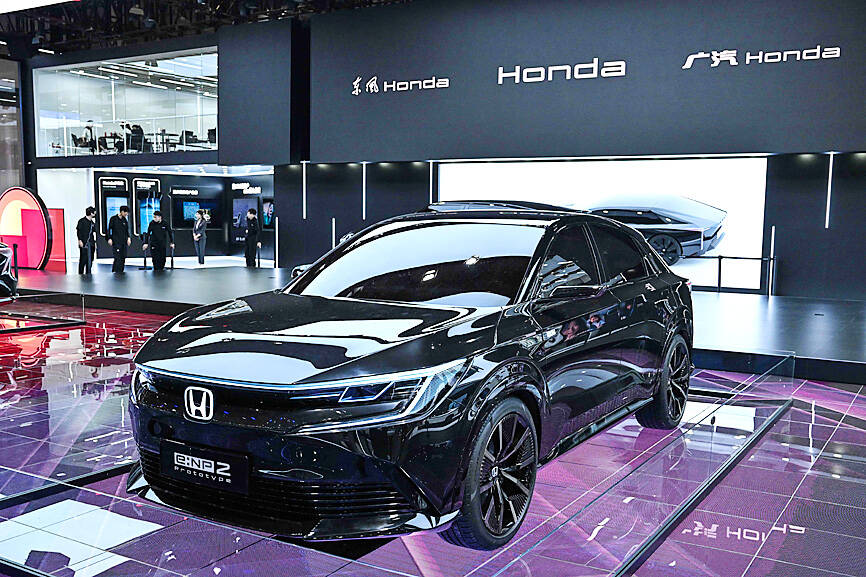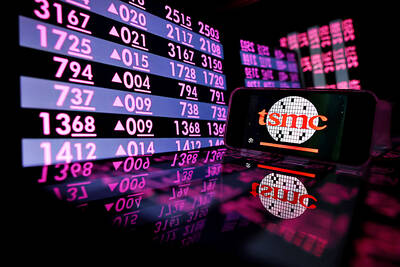Honda Motor Co is gearing up for an electrification shift in North America with two models developed with General Motors Co going on sale next year and a bigger electric vehicle (EV) with a new platform in 2025, a year earlier than initially announced.
“We believe that the value society places on being kind to the environment will only build in momentum,” Honda president Toshihiro Mibe said yesterday in announcing a sprawling set of initiatives intended to put the automaker on the global EV map.
Mibe told reporters that Tokyo-based Honda would forge ahead on investments and partnerships to realize such goals.

Photo: AFP
Honda has set a goal to offer all its models around the world as EVs or equipped with fuel cells, which run on hydrogen and are emissions-free, by 2040. It aims to make more than 2 million EVs a year by 2030.
In Japan, where EV demand is picking up gradually, an EV based on the N-ONE model goes on sale in 2025. Two more EV models are planned for the following year.
In China, the world’s biggest EV market, the Japanese automaker has three electic models going on sale next year — the e:NS2, the e:NP2 and a concept unveiled at Auto Shanghai last week.
Honda said it would introduce seven more EV models in China by 2027.
By 2035, Honda aims for 100 percent EVs for its China sales, ahead of other regions.
All the world’s automakers are getting serious about EVs, now dominated by Tesla Inc and China’s BYD Co (比亞迪). With governments moving to curb emissions and climate change, even previously skeptical consumers are starting to buy EVs, especially in the US and China, but also in parts of Europe and in Australia.
The big question is whether Japanese manufacturers, such as Honda and Toyota Motor Corp, would be able to dominate the market as they have historically with gasoline-powered vehicles.
The main drawback for the proliferation of EVs is the battery, which is heavy, a challenge in auto development. The components needed to make batteries, such as rare earths, are expensive.
Honda plans to leverage its strategic partnership with Hanwa Co, a Japanese trading company, to ensure stable procurement of nickel, cobalt and lithium for batteries, Mibe said.
In North America, Honda would use batteries from General Motors and a joint venture with South Korea’s LG Energy Solution. Honda would make electric models in the US at its three plants in Ohio, including the Marysville plant.
Under the US’ Inflation Reduction Act, signed by US President Joe Biden last year, to qualify for full tax credits, EVs must be assembled in North America, and a certain percentage of their battery parts and minerals have to come from North America or a US free-trade partner.
Honda is also working on developing solid-state batteries for EVs, Mibe said.
EVs now run mostly on lithium-ion batteries.
Honda’s 2025 platform is called “E&E architecture,” for “electric and electronic,” referring to the software, connectivity and services that work while driving and are updated over time.
Automakers are expected to be competing in this area.
Mibe said Honda has dealt with the recent shortage of computer chips that have hit all automakers, partly due to restrictions related to the COVID-19 pandemic.
Honda has reached a basic agreement with Taiwan Semiconductor Manufacturing Co (TSMC, 台積電), the world’s largest semiconductor maker, to guard against such shortages in the future.
“We hope to lead the world in ecological manufacturing,” Mibe said.

Zhang Yazhou was sitting in the passenger seat of her Tesla Model 3 when she said she heard her father’s panicked voice: The brakes do not work. Approaching a red light, her father swerved around two cars before plowing into a sport utility vehicle and a sedan, and crashing into a large concrete barrier. Stunned, Zhang gazed at the deflating airbag in front of her. She could never have imagined what was to come: Tesla Inc sued her for defamation for complaining publicly about the vehicles brakes — and won. A Chinese court ordered Zhang to pay more than US$23,000 in

Taiwan Semiconductor Manufacturing Co (TSMC, 台積電) yesterday said that its investment plan in Arizona is going according to schedule, following a local media report claiming that the company is planning to break ground on its third wafer fab in the US in June. In a statement, TSMC said it does not comment on market speculation, but that its investments in Arizona are proceeding well. TSMC is investing more than US$65 billion in Arizona to build three advanced wafer fabs. The first one has started production using the 4-nanometer (nm) process, while the second one would start mass production using the

‘NO DISRUPTION’: A US trade association said that it was ready to work with the US administration to streamline the program’s requirements and achieve shared goals The White House is seeking to renegotiate US CHIPS and Science Act awards and has signaled delays to some upcoming semiconductor disbursements, two sources familiar with the matter told reporters. The people, along with a third source, said that the new US administration is reviewing the projects awarded under the 2022 law, meant to boost US domestic semiconductor output with US$39 billion in subsidies. Washington plans to renegotiate some of the deals after assessing and changing current requirements, the sources said. The extent of the possible changes and how they would affect agreements already finalized was not immediately clear. It was not known

A TAIWAN DEAL: TSMC is in early talks to fully operate Intel’s US semiconductor factories in a deal first raised by Trump officials, but Intel’s interest is uncertain Broadcom Inc has had informal talks with its advisers about making a bid for Intel Corp’s chip-design and marketing business, the Wall Street Journal reported, citing people familiar with the matter. Nothing has been submitted to Intel and Broadcom could decide not to pursue a deal, according to the Journal. Bloomberg News earlier reported that Taiwan Semiconductor Manufacturing Co (TSMC, 台積電) is in early talks for a controlling stake in Intel’s factories at the request of officials at US President Donald Trump’s administration, as the president looks to boost US manufacturing and maintain the country’s leadership in critical technologies. Trump officials raised the